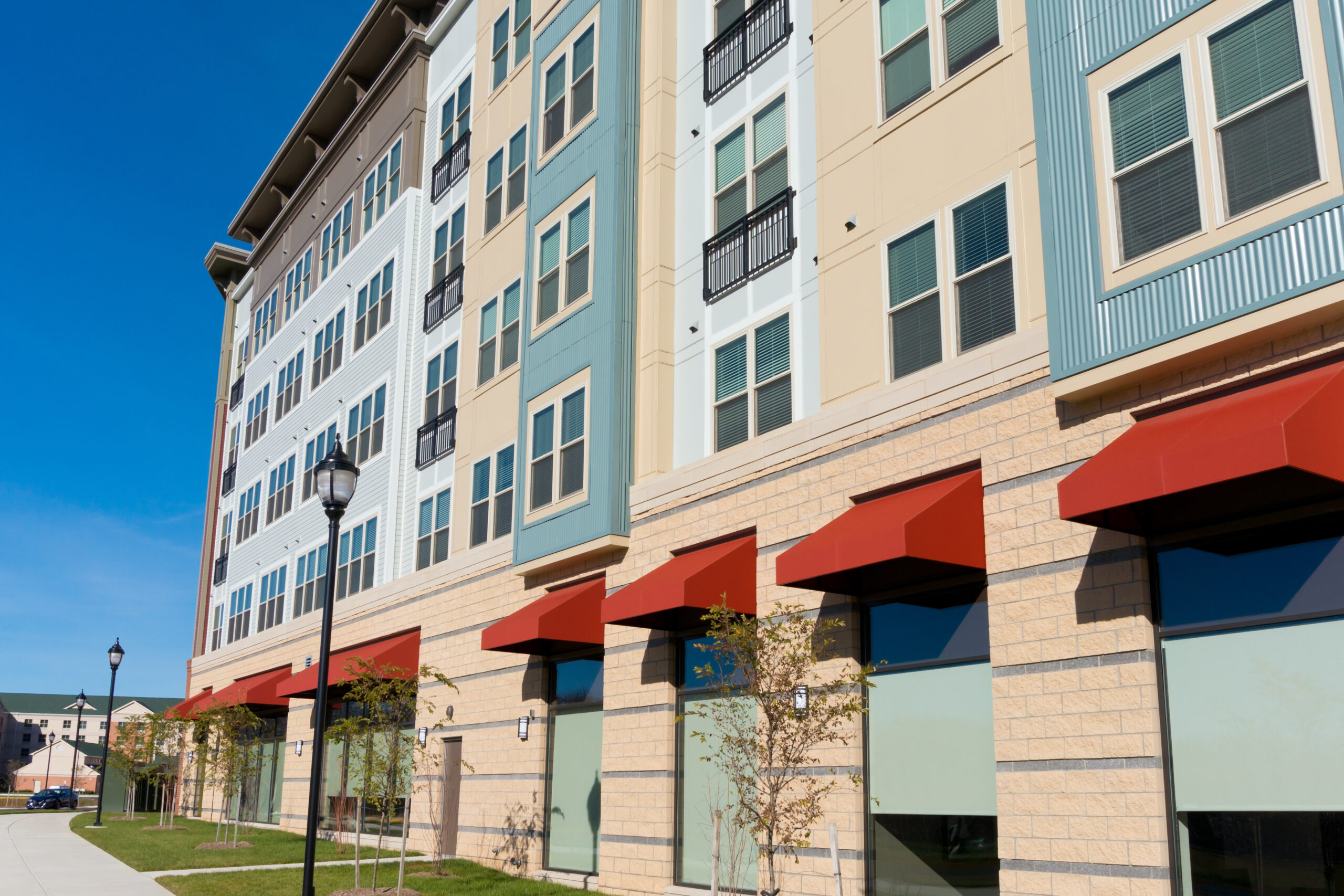
Podium structures have been gaining popularity especially within the past several years. There has been an increase in the demand for multi-story mixed-use and multi-unit residential structures. Podium structures are typically used to take advantage of simpler and less expensive wood construction for the upper portion of the building, while also complying with code requirements for non-combustible portions of the building, fire separations, and height limits on types of construction.
What is a Podium Structure?
A podium structure is typically used for residential units with parking or retail at the lower level(s). The podium level is also referred to as platform or transfer level that supports a bearing-wall system structure above.
There are several bearing wall structural systems that may be used for the residential superstructures (buildings) supported on a podium level. These systems will vary greatly in terms of dead loads and consequently will greatly affect the structural demand on the podium and foundations.
Types of Bearing Wall Systems
The following is a list of typical bearing wall systems in the order of common use and effect on the superimposed loads on the podium framing and foundations as well as based on the relative cost of each system:
- Pre-engineered floor and roof trusses supported on wood bearing walls. This might also include the use of pre-engineered joists and standard wood joists in some areas. Typically, this system may be used for up to 4 levels above the podium level.
- Cold Formed Metal Framed (CFMF) framing system consisting of floor metal C-joists supported on metal studs. This system includes the use of a topping slab on formed deck. This system is typically used for 5 levels or more above the podium level.
- Pre-engineered metal trusses (composite or non-composite) supported on metal studs. This system includes the use of a topping slab on formed metal deck. This system may also be used for 5 levels or more above the podium level.
- Precast hollow concrete planks with topping supported on metal studs. This system may also be used for 5 levels or more above the podium level. Relatively, this is the heaviest system amongst the others.
There are typically 2 common structural framing systems for podiums:
- Structural steel framing system using composite floor construction
- Reinforced concrete typically using flat slab system with beams, drop panels, thickened slabs, etc.
Structural Workshop has designed many podium structures over the past several years with approx. 75% of the buildings using reinforced concrete (mainly flat slabs). One of the main contributing and decisive factors in the decision making was the bearing capacity of the soil. In all these buildings, the soil was suitable for shallow foundations with very good bearing capacity.
The following table highlights the main pros and cons for each of the 2 mostly common framing systems used in the construction of the podium level:
| Pros | Cons | |
| Reinforced Concrete Framing | – Ease of construction for buildings with irregular geometry and projections past the façades. – Soundproofing – Natural fire resistance characteristics – Minimum floor construction depth (floor-to-floor height) – Ceiling may be left exposed (painted) for flat plates – Single trade at the site (concrete) – Ideal parking levels below the podium (durability). | – Relatively a heavy framing system: The dead load of a reinforced concrete framing system may be as much as 3 to 4 times the weight of an equivalent structural steel framing system. – Requires additional care and quality control during construction: Concrete mix, transportation, pouring, rebar placement, finishing, temperature, curing, shoring, etc. – Shrinkage and long-term creep (deflection) |
| Structural Steel Framing | – Relatively fast construction – Relative cost is less than concrete – Least dead loads for a transfer system on the foundations, especially for longer spacing between columns – Competitive bidding especially compared to flat slab projects – Better control for stiffness requirements (especially for long term deflection) – Smaller columns are typically used – Sustainability especially with the use of recycled steel | – Multiple trades/steps: frame, decking, studs, concrete – Usually requires considerable effort for the design of the connections – Floor construction depth – Fireproofing requirements – Use of suspended ceiling – Columns encasement/protection at lower parking level (if any) |
There are several factors that governs the selection criteria to ensure the use of an optimal system that satisfies both the structural demand and the project budget. The following is a list of some of the critical parameters that will affect the selection of a viable, economical, and optimal system that better suits a specific project:
- The type of bearing walls system used for the superstructure above the podium level in regards of the superimposed dead load at the transfer level.
- Type of Foundations Recommended for the Building:
- Shallow foundations with relatively high bearing capacity
- Shallow foundations with low bearing capacity
- Deep foundations (piles) and the capacity of the proposed type of piles
- Lateral demand on the building (wind, seismic and flood loads)
- Floor(s) use below the podium level. This would affect the column spacing and hence the structural demand on the podium framing system
- Residential
- Parking
- Retail
- Available floor-to-floor height below the podium and maximum building height
- Total cost and allocated budget for the project
- Client preference and performance requirements
In summary, there are many factors that affect the choice of the framing system for podium structures. These factors will vary from one project to another. Typically, the structural engineer should make recommendations for the most suitable system for any given project depending on the structural demand and design criteria. Ultimately, the client might have the final word for selecting the type of framing system based on preference, budget, performance, and expectations.
If you would like to learn more about podium structures, please contact us today: [email protected]
